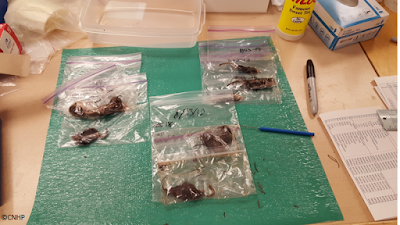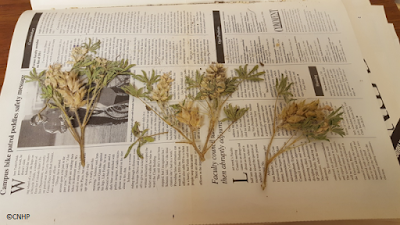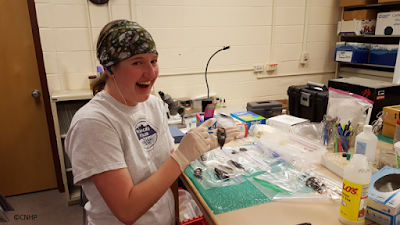By Alyssa Meier
At the end of the hall here at CNHP, there is a small lab in which, not ten feet apart, sit two very different worlds. On one side, we have a freezer filled to the brim with shrew specimens dating back to 2012. On the other, a cabinet loaded to the top with plant specimens all the way from 1993.
 |
| Collection of shrew specimens. |
 |
| Shelf of plant specimens from the 90s. |
This past semester, I had the privilege of being a part of two projects that dealt with these specimens. The first project involved taking the old plant specimens, digging through twenty-year-old field journals, and trying to glean enough information to make a label so I could turn them in to the Colorado State University Herbarium. The second involved separating the shrews into individual baggies and giving each a catalog number so we could cart them off to the Denver Museum of Nature and Science.
Each of these projects had its own merits. Making labels for the plants involved a bit of detective work. I was snooping into the past—the far-off years of the 90s when I was just a kid and these plants were still alive. Of course, the field journals of each individual botanist had their own nuances to navigate just to obtain any relevant information, and this sometimes involved tracking down GIS files and surfing through records in Biotics. Many times the information was simply lost over the years.
 |
| A pressed rusty lupine (Lupinus pusillus) specimen. |
Comparatively, working with shrew specimens was an overload of information. Dozens of grocery bags loaded with sandwich bags loaded with shrews. All of them frozen together. The unfortunate thing about studying shrews is that, because they are so small, it is difficult to draw any inference on habitat or location without the use of pitfall traps or other lethal methods. Thus, the specimens collected are bagged and frozen together. My job was to thaw out the shrews (the smell is indescribable), meticulously peel them apart (so I don’t accidentally rip them in half), put them in separate snack bags, and give them a catalog number.
 |
| Me gently peeling apart two shrews that have been frozen together. |
Botany and zoology—they both have their ups and downs. One thing’s for certain: reeking shrews and crispy plants are still better than case changes.




